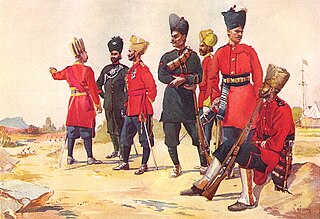
The 119th Infantry was an infantry regiment of the British Indian Army. The regiment originated in 1817, when it was raised as the 1st Battalion, 10th Regiment of Bombay Native Infantry.
The 108th Infantry were an infantry regiment of the British Indian Army. The regiment traces their origins to 1768, when they were raised as the 1st Battalion, Bombay Sepoys.

The 109th Infantry was an infantry regiment of the British Indian Army. The regiment traces its origins to 1768, when it was raised as the 5th Battalion, Bombay Sepoys.

The 112th Infantry were an infantry regiment of the East India Company's Bombay Army and lather the British Indian Army. The regiment traces their origins to 1796, when they were raised as the 2nd Battalion, 6th Regiment of Bombay Native Infantry.

The 113th Infantry were an infantry regiment of the British Indian Army. The regiment traces their origins to 1800, when they were raised as the 1st Battalion, 7th Regiment of Bombay Native Infantry.

The 104th Wellesley's Rifles were an infantry regiment of the British Indian Army. They could trace their origins to 1775, when they were raised as the 5th Battalion, Bombay Sepoys and presently its designation is 3 Guards(1 Rajputana Rifles) of Indian Army.

The 120th Rajputana Infantry were an infantry regiment of the British Indian Army. The regiment traces their origins to 1817, when they were raised as the 2nd Battalion, 10th Regiment of Bombay Native Infantry.
The 102nd Prince of Wales's Own Grenadiers was an infantry regiment of the British Indian Army. It could trace its origins to 1796, when it was raised as the 13th Battalion, Bombay Native Infantry.
The 80th Carnatic Infantry were an infantry regiment of the British Indian Army. They could trace their origins to 1777, when they were raised as the 21st Carnatic Battalion, by enlisting men from the 2nd, the 6th, the 12th and the 15th Carnatic Battalions.
The 87th Punjabis were an infantry regiment of the British Indian Army. They could trace their origins to 1798, when they were raised as the 1st Battalion, 14th Madras Native Infantry.
The 88th Carnatic Infantry were an infantry regiment of the British Indian Army. They could trace their origins to 1798, when they were raised as the 2nd Battalion, 14th Madras Native Infantry.

The 103rd Mahratta Light Infantry were an infantry regiment of the British Indian Army. They could trace their origins to 1768, when they were raised as the 2nd Battalion, Bombay Sepoys. The regiment was first in action in the Mysore Campaign during the Third Anglo-Mysore War, quickly followed by the Battle of Seedaseer and the Battle of Seringapatam in the Fourth Anglo-Mysore War. Their next action was at Beni Boo Ali against pirates in Eastern Arabia and the Persian Gulf region led the East India Company to carry out a punitive expedition in 1819 to Ras al Khaimah which destroyed the pirate base and removed the threat from the Persian Gulf.

The 105th Mahratta Light Infantry were an infantry regiment of the British Indian Army. The regiment traces their origins to 1768, when they were raised as the 3rd Battalion, Bombay Sepoys.

The 107th Pioneers were an infantry regiment of the British Indian Army. Their origin can be traced back to 1788, when they were raised as the 4th Battalion, Bombay Sepoys.

The 110th Mahratta Light Infantry were an infantry regiment of the British Indian Army. The regiment traces their origins to 1797, when they were raised as the 2nd Battalion, 5th (Travancore) Regiment of Bombay Native Infantry.

The 116th Mahrattas were an infantry regiment of the British Indian Army. The regiment traces their origins to 1800, when they were raised as the 2nd Battalion, 7th Regiment of Bombay Native Infantry.

The 117th Mahrattas were an infantry regiment of the British Indian Army. The regiment traces their origins to 1800, when they were raised as the Bombay Fencible Regiment.
The 121st Pioneers were an infantry regiment of the East India Company's Bombay Army and lather the British Indian Army. The regiment traces their origins to 1777, when they were raised as the Marine Battalion.

The 122nd Rajputana Infantry were an infantry regiment of the British Indian Army. The regiment traces their origins to 1818, when they were raised as the 2nd Battalion, 11th Regiment of Bombay Native Infantry.
The 128th Pioneers were an infantry regiment of the British Indian Army. The regiment traces their origins to 1846, when they were raised as the 28th Bombay Native Infantry.






